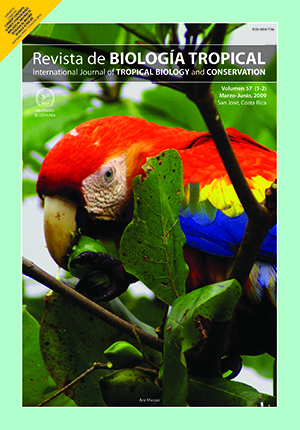Abstract
We determined the floristic and physiognomic aspects of disturbed thorny xerophytic scrubland in Punta de Piedras, Miranda Municipality, Zulia State, Venezuela. Botanical sampling was done twice monthly (November 2005-June 2006), in both rainy and dry seasons, for a total of 16 samples. The sampling was done in 10 vegetation patches, in an average area of 718,2 ± 706,24 m2, and adjacent graminoid floristic components were identified using three 400 m2 (20 x 20 m) plots, divided into 4 subplots (20 x 5 m2) and in these, were delimited 12 subplots (1 x 1 m2). In addition, human paths were carried out in order to identify other species plant. Thorny xerophytic scrubland showed human disturbances e.g. periodic fires, solid wastes, roads and human settlements and coastal semiarid thorny scru- bland characteristics, similar to another Venezuelan localities. Forty-five species, in 22 families were identified, and the Poaceae (6), Mimosaceae (4), Boraginaceae (3), Cactaceae (3), Caesalpinaceae (3), Euphorbiaceae (3) and Fabaceae (3) presented the highest number of species. Human disturbances probably favor the appearance of vegetation patches and secondary grassland formations. In the last, Aristida venesuelae, Aristida pittieri y Portulaca pilosa showed the highest relative abundances and frequencies values with a summatory of 49,38% and 46,86%, respectively, while in the patches there were observed two layer: an herbaceous layer (less than 1 m high) as well as a bush-tree layer (2.63 ± 1.37 m high), comprised mostly of Opuntia wentiana, Piptadenia flava and Jatropha gossypifolia with relative abundances of 32,82, 15,60 and 15,14 %, respectively. The thorny xerophytic scrubland in Punta de Piedras presents a low number of species; however, the physiognomic char- acteristics are similar to other undisturbed thorny xerophytic scrublands in Venezuela.
This work is licensed under a Creative Commons Attribution 4.0 International License.
Copyright (c) 2009 Revista de Biología Tropical
Downloads
Download data is not yet available.

